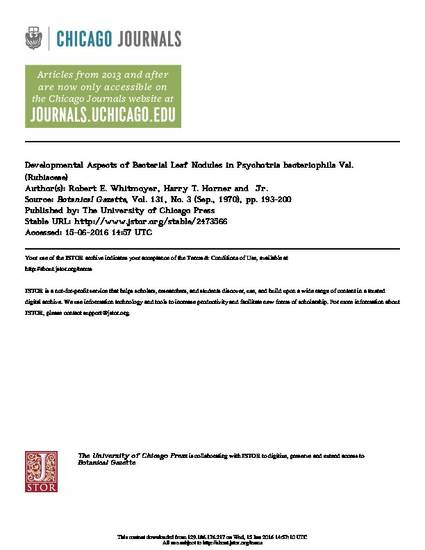
Article
Developmental Aspects of Bacterial Leaf Nodules in Psychotria bacteriophila Val. (Rubiaceae)
Botanical Gazette
Document Type
Article
Disciplines
Publication Version
Published Version
Publication Date
9-1-1970
Abstract
The ontogeny and biological activity of bacterial leaf nodules in Psychotria bacteriophila were studied. The acridine-orange fluorescence method coupled with ribonuclease extractions showed that young and developing nodules were rich in ribonucleic acid (RNA), whereas nodules in older leaves displayed less RNA fluorescence, and nodules in leaves near absciscion did not fluoresce. Fluorescence was attributed to normal and dividing ribosome-rich bacteria. As nodules age, the bacterial population becomes crowded, and de- generating bacteria appear. The latter become a membrane mass which fills the nodule network, replacing the bacteria. The loss of fluorescence is therefore correlated with bacterial cell degeneration. These results suggest that the nodule activity is high in young and maturing leaves and decreases in mature leaves and in leaves nearing abscission. Therefore, the presumed beneficial aspects of this symbiosis appear to occur ear]y in nodule development.
Copyright Owner
The University of Chicago Press
Copyright Date
1970
Language
en
File Format
application/pdf
Citation Information
Robert E. Whitmoyer and Harry T. Horner. "Developmental Aspects of Bacterial Leaf Nodules in Psychotria bacteriophila Val. (Rubiaceae)" Botanical Gazette Vol. 131 Iss. 3 (1970) p. 193 - 200 Available at: http://works.bepress.com/harry-horner/15/

This article is from Botanical Gazette 131 (1970): 193. Posted with permission.